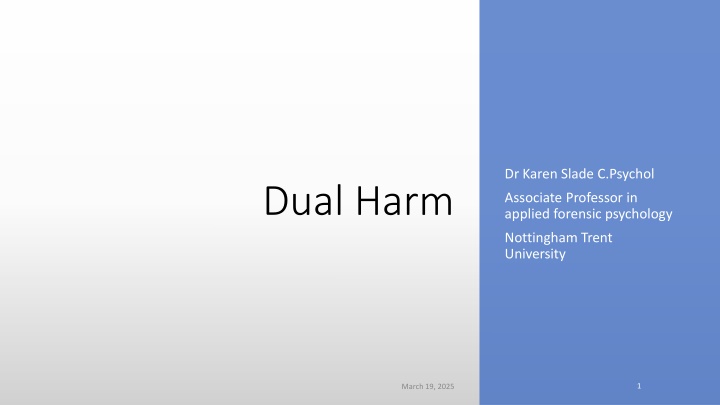
Link Between Violence and Self-Harm: Understanding the Dual Harm Connection
Exploring the relationship between violence and self-harm, this research sheds light on the significant correlation between these behaviors, particularly in forensic and prison settings. Dr. Karen Slade delves into the risk factors, incident rates, and characteristics of dual harm individuals, aiming to uncover crucial insights for intervention and prevention strategies.
Download Presentation

Please find below an Image/Link to download the presentation.
The content on the website is provided AS IS for your information and personal use only. It may not be sold, licensed, or shared on other websites without obtaining consent from the author. If you encounter any issues during the download, it is possible that the publisher has removed the file from their server.
You are allowed to download the files provided on this website for personal or commercial use, subject to the condition that they are used lawfully. All files are the property of their respective owners.
The content on the website is provided AS IS for your information and personal use only. It may not be sold, licensed, or shared on other websites without obtaining consent from the author.
E N D
Presentation Transcript
Dr Karen Slade C.Psychol Dual Harm Associate Professor in applied forensic psychology Nottingham Trent University 1 March 19, 2025
The link between violence and self-harm or suicidal behaviour Community Violence Exposure to violence increases risk of SH and suicide ideation (Vermeiren, et al. 2002) Systematic review Evidence suggests that aggression and SH frequently co-occur with most patients who engaged in self-harm engaged in aggression (74%), whereas most patients who engaged in aggression did not engage in self-harm (20%) (O Donnell, House and Waterman, 2015). Violent offences have consistently been the most serious offence associated with the deceased person s detention (53%) (Australian Government, 2015) BUT conducting repeated violence is a stronger risk of suicidal behaviour (Jordan & Samuelson, 2015) Prison Violence Relationship between violence and SH in prisoners has, so far, largely been correlating SH with violent convictions (Static) with few institutional studies. Those who engage in institutional physical violence has been demonstrated to be linked with suicide and self-harm behaviour (e.g. lifetime link: Mann et al., 1999) USA study (Young et al, 2006) suggested that prisoners in healthcare units who self-harmed were 8 times more likely to assault a staff member. USA: Lanes (2011) demonstrated that male prisoners who self-harm were more likely to be violent and be in segregation. UK: Women Kottler et al. (2018) Very recently confirmed that 40% of women who self-harmed were also violent with higher incidence of ligature and firesetting.
What we know and what we dont We know that violence and self-harm are very clearly linked behaviours. Shown in all populations in which it has been researched. But We don t know the characteristics of this group except in the highly exceptional situation when the harm is fatal (homicide-suicide). We don t know the range of other behaviours We don t know the level of risk posed by these (and other) behaviours We don t know why they are linked. We don t know whether it matters.
To explore possible risk factors for dual harm prisoners. Therefore, this study will aim to compare sole self- harm, sole assault and dual harm prisoners: To explore demographic variables and offence types To explore incident rates, incident types and (where applicable) rates of restrictive punishment regimes. To explore any differences in methods or lethality of self-harm. Aims
Exploring Sole and Dual Harm Location Groups Medium Security (Cat B) Remand and early stage prison in England (based on in-prison incidents) Sole Assault (physical assault) Sole Self-harm (physical harm to self) Dual Harm: Both assault and self-harm No incidents No harm (incidents but not physical harm)
Method Data: Routinely gathered detailed incident, location and demographic data from electronic database system Each participant had demographic, current offence, incident dates and incident types, dates of segregation and placement on basic regime recorded. Further details on method and severity of self-harm behaviour was also gathered. 19 March 2025 6
Definitions Assault: Assaults in prison custody cover a wide range of physically violent incidents including fights between prisoners. Self-harm: Any act where a prisoner deliberately harms themselves irrespective of the method, intent or severity of any injury. Reportable Incident: Any incident, as outlined in HM Prison Service Order 1400, which requires staff to report it onto the PNOMIS electronic computer system. These include: assault, self-harm, damage to property, fire, drugs, mobile phone possession, death of a prisoner, miscellaneous, incidents at height, tool possession and barricade.
N(%) Sole Self-Harm 70 (7.3) Dual Harm 105 (10.9) Sample Sole Assault 223 (23.1) No Harm 86 (8.9) No Incidents 481 (49.8) Total 965 19 March 2025 8
Index offence Logistic Regression undertaken considering whether we could distinguish dual from either sole self-harm or sole assault groups on the basis of their current offence type. The following offence types were coded: Violent Sexual Acquisitive Drugs Arson All analyses were all non-significant (p>. 05), meaning offence type does not distinguish the harm groups.
Years in Prison ANOVA Significant difference in time in prison p <.001 Dual vs all other groups.
Rate of wider incidents (per person year)
#Self-harm Kruskal-Wallis test confirmed that there was no significant difference in the number of self-harm incidents between the dual and sole self-harm group, p =.361
#fire Kruskal Wallis confirmed that dual harm have far greater rate of fire incidents than any other group, p <.0001 for all comparisons. Relative Risk of dual harm prisoners ever setting a fire in prison was calculated: Dual vs SH: 4.8; Dual vs Asst: 3.6 Dual harm prisoners 3-4 times more likely to set a fire at some point.
#property damage Kruskal-Wallis tests revealed that Dual harm also have greater rate of damage and disorder incidents than all other groups, p <.001 for all comparisons.
Total Incidents (per person year) All incidents (not including self-harm or assault) per person year. Kruskal-Wallis test revealed dual harm had significantly higher rate than all other groups (p <.001 for all comparisons).
Punishment experience Basic regime experience N (%) Segregation experience N (%) 186 (83) 110 (49) Assault Only 103 (98) 84 (80) Dual 67 (78) 31 (37) Incident but no harm 45 (64) 19 (27) Self-harm 401 (83) 244 (50) Total <.001 <.001 p (Dual vs the rest) 19 March 2025 17
Restrictive regimes Segregation N WEEKS SD Mean 14.15 Group DAYS M (SD) Basic Regime Assault 164 14.17 Dual 79 30.17 23.98 Assault Only 19.84 (48.45) No harm 69 4.98 6.42 Dual 51.04 (71.5) SH 58 4.31 6.91 Total 441 12.12 16.93 No harm 4.76 (13.8) SH only 7.05 (27.45) 19 March 2025 18
Dual Harm Self-harm method
Method of self-harm All self-harm N = 175 N (%) Self-harm only (N = 70) N (%) Dual (N =105) N (%) p OR (95% CI) Type of self-harm 68 (38.9) 20 (28.6) 48 (45.7) .024 2.1 (1.1 .014) Ligature/Self-strangulation 127 (72.6) 50 (71.4) 77 (73.3) .782 1.1 (.56 2.16) Cuts 39 (22.3) 10 (14.3) 29 (27.6) .041 2.29 (1.03 5.07) Overdose 10 (5.7) 5 (7.1) 5 (4.8) .509 .65 (.18 2.33) Headbanging 13 (7.4) 2 (2.9) 11 (10.5) .079 3.98 (.85 18.53) Punched wall or self 14 (8) 3 (4.3) 11 (10.5) .152 2.61 (.70 9.73) Swallowed item 11 (6.3) 3 (4.2) 8 (7.6) Other (insertion, burns, kicking, set fire, NPS) Odds Ratio indicates the risk of ligature or overdose is x2 those in the Sole SH group 20 19 March 2025
Number of SH Methods (max of 7) Methods Dual % Self-harm % 1 55 79 Mann Whitney U-test confirmed that Dual Harm (Mdn = 1.66) used a greater range of methods of SH than Sole self-harm (Mdn = 1.24) (U = 2,769, P = .001) 2 24 14 3 11 4 4 8 1 5 2 1 6 1 0 21 19 March 2025
Amongst an in-prison self-harm population: 40-60% also have an assault in prison. Amongst the full offender population: Dual Harm 11%. Summary of Dual Harm Amongst an in-prison self-harm population: 40-60% also have an assault in prison. Far greater rate of other incidents (particularly fire, damage) but not of self-harm. No differences in index offence but far longer experience of both prison and of restrictive regimes . Wider range of self-harm methods used and greater use of ligature and overdose
Discussion Dual harm risks are not limited to one behaviour, but a potential range of harmful behaviours. There is no difference in the annual rate of self-harm, but higher rates of fire setting and property damage (in addition to violence). The pattern looks more like the self- harm group. However, the greater variability of behaviours creates an overall picture of far higher rates of incidents and greater overall risk of harm. Due to high levels of incident they will experience significant levels of punishment and restrictive regime (without seemingly much effect). This is more like the assault group. Dual harm offenders seem to have a pattern of behavioural variability which changes over time and across spheres, including SH methods. Managing one risk at a time may be unlikely to result in lasting impact on overall risk of harm. Coupled with greater use of more lethal methods i.e. ligature and overdose, they may be more at risk of self-inflicted death or serious harm. They will be resource intensive and with changing behaviour patterns, single case management is recommended across services.
Previous paper: Slade, K. (2017) Dual Harm: An exploration of the presence and characteristics for dual violence and self- harm behaviour in prison. Journal of Criminal Psychology (online). Please contact me if you d like the slides, papers or interested in research avenues: karen.slade@ntu.ac.uk 24 19 March 2025

